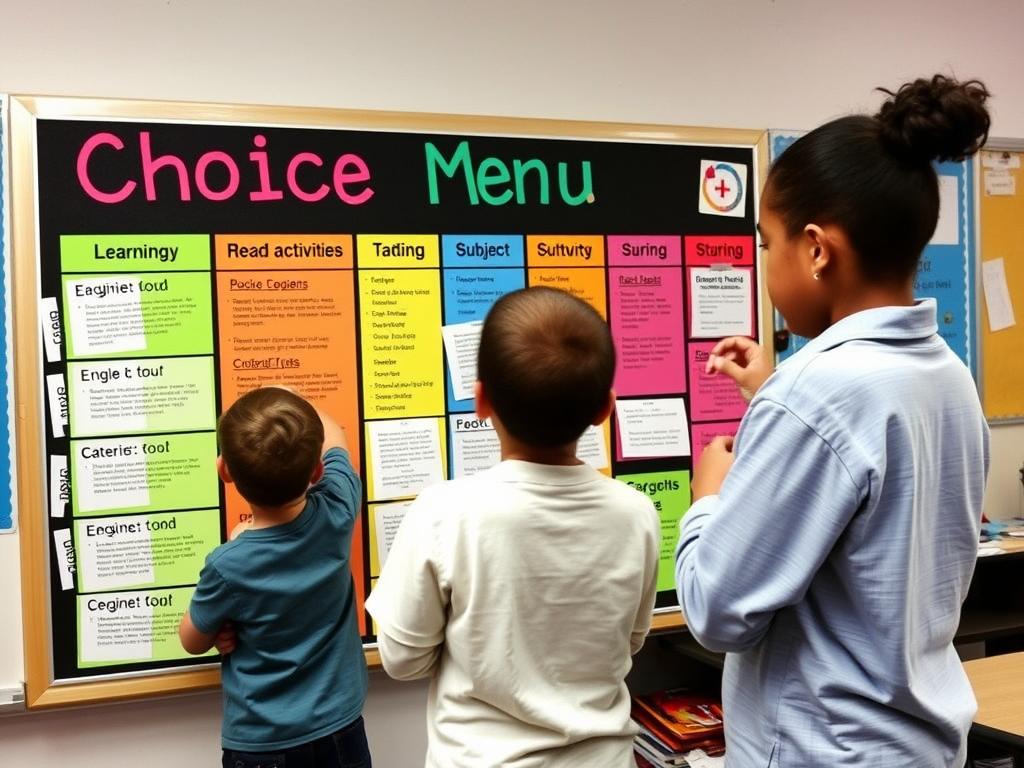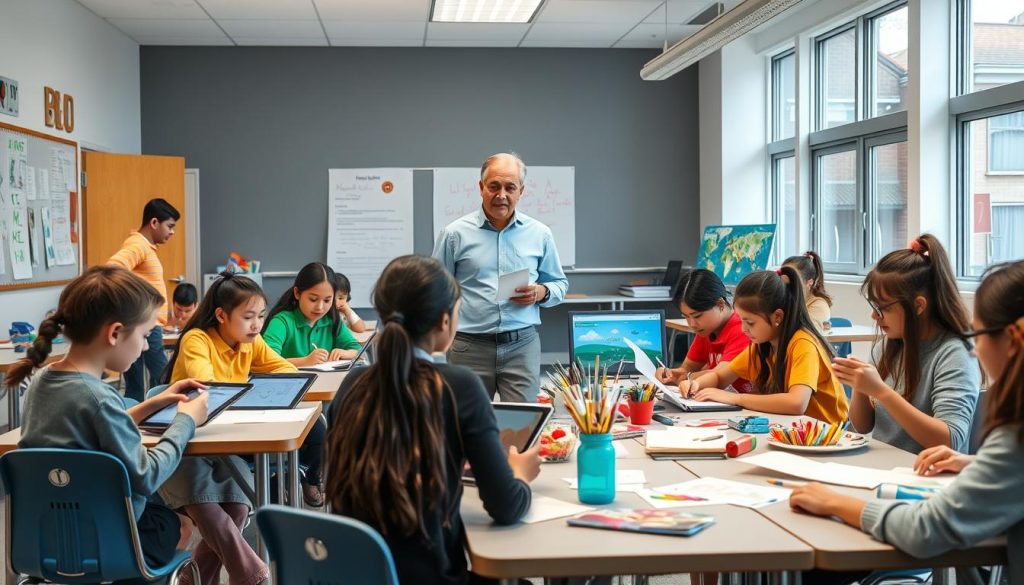Why Choices Matter: The Science Behind Student Agency
The research is clear: providing students with meaningful choices in their learning experiences leads to increased motivation, engagement, and academic achievement. According to a comprehensive study published in Educational Psychologist, when students perceive they have choice, they demonstrate greater persistence in tasks and deeper conceptual understanding of material.
But not all choices are created equal. Effective implementation of choice requires specific teacher skills that transform simple options into powerful learning opportunities. These teacher skills include understanding the psychology of motivation, designing appropriate choice parameters, and facilitating student decision-making processes.
The neuroscience behind choice is fascinating. When students make choices about their learning, the brain’s reward pathways activate, releasing dopamine that enhances attention and memory formation. This biological response explains why choice-driven learning tends to be more memorable and impactful than prescribed approaches.
Enhance Your Teacher Skills in Choice-Based Learning
Discover practical strategies for implementing meaningful student choice in your classroom while maintaining curricular alignment.
How Choices Matter: Different Types of Student Choice
Implementing choice in the classroom isn’t simply about letting students do whatever they want. Effective choice implementation requires sophisticated teacher skills in designing appropriate options that still meet learning objectives. Let’s explore the different types of choices you can offer students:
Procedural Choices
These choices involve how students complete their work. Examples include:
- Choosing where to sit in the classroom
- Selecting which problem to solve first
- Determining whether to work alone or with partners
- Deciding which tools or resources to use
Procedural choices are often the easiest to implement and can be a great starting point for teachers new to choice-based learning.
Content Choices
These choices involve what students learn about. Examples include:
- Selecting a book from an approved list
- Choosing a historical figure to research
- Determining which science concept to explore in depth
- Picking a math problem-solving strategy
Content choices require more advanced teacher skills in curriculum design but can significantly boost student interest.
Assessment Choices
These choices involve how students demonstrate their learning. Examples include:
- Creating a video presentation instead of writing a paper
- Building a model rather than taking a test
- Designing a website to showcase understanding
- Performing a skit instead of giving a speech
Assessment choices allow students to leverage their strengths while still demonstrating mastery of content.
Pacing Choices
These choices involve when and how quickly students complete work. Examples include:
- Working through a learning module at their own speed
- Choosing which day to take an assessment
- Determining how to allocate time across multiple tasks
- Selecting deadlines within a given timeframe
Pacing choices help students develop time management skills and self-regulation.
Implementing these various types of choices requires different teacher skills, from organizational abilities to assessment design expertise. The key is starting small and gradually expanding choice as both you and your students become more comfortable with the approach.

When Choices Matter: The Benefits for Students and Teachers
The implementation of meaningful choice in the classroom yields significant benefits for both students and teachers. Understanding these benefits can help educators develop the teacher skills necessary to effectively implement choice-based learning approaches.
Benefits for Students
- Increased motivation: When students have a say in their learning, intrinsic motivation typically increases.
- Greater engagement: Choice leads to higher levels of active participation and time on task.
- Improved academic performance: Research shows that choice often correlates with better learning outcomes.
- Enhanced creativity: Having options encourages students to think more creatively about their approach to learning.
- Stronger decision-making skills: Regular practice making choices builds this essential life skill.
- Increased ownership: Students take more responsibility for their learning when they’ve had a hand in shaping it.
- Better self-regulation: Making and following through on choices builds executive function skills.
Benefits for Teachers
- Fewer behavior issues: Engaged students typically exhibit fewer disruptive behaviors.
- More differentiated instruction: Choice naturally accommodates different learning needs and preferences.
- Richer assessment data: Varied outputs provide more insight into student understanding.
- Increased job satisfaction: Many teachers report greater enjoyment when facilitating choice-based learning.
- More authentic relationships: Honoring student agency builds trust and respect.
- Professional growth: Implementing choice develops important teacher skills that enhance overall effectiveness.
- Classroom community: Choice-based environments often foster stronger classroom communities.
These benefits don’t materialize automatically—they require intentional design and implementation. Developing the teacher skills to effectively structure choice while maintaining high academic standards is essential for success.
Develop Your Teacher Skills in Student Choice
Join thousands of educators who have enhanced their teaching practice through our professional development opportunities.
How Choices Matter: Implementation Strategies for Your Classroom
Translating the theory of student choice into classroom practice requires specific teacher skills and thoughtful planning. Here are practical strategies for implementing meaningful choice in your classroom:
1. Start Small and Build Gradually
One of the most important teacher skills is knowing how to introduce new approaches incrementally. Begin with simple procedural choices before moving to more complex content or assessment choices.
“I started by simply letting students choose where to sit during independent reading time. The positive response was immediate, and it gave me confidence to expand choice in other areas.”
2. Use Choice Boards and Learning Menus
Choice boards and learning menus are structured formats that present students with multiple options for learning activities or assessments. Creating effective choice boards is a valuable teacher skill that balances freedom with appropriate constraints.
| Choice Board Type | Best For | Structure | Example |
| Tic-Tac-Toe | Elementary students | Nine options in a 3×3 grid; students complete three in a row | Reading response activities for a novel study |
| Must-Do/May-Do | All grade levels | Required tasks plus optional enrichment activities | Math practice with required skill work and optional challenge problems |
| Learning Menu | Middle/High school | Appetizers (intro activities), Entrees (core content), Desserts (extension) | Science unit with introductory videos, lab experiments, and research projects |
| Think-Tac-Toe | Upper elementary/Middle | Activities organized by learning style or Bloom’s taxonomy levels | Social studies activities organized by visual, auditory, and kinesthetic preferences |
3. Implement Project-Based Learning
Project-based learning naturally incorporates choice as students determine their approach to solving a problem or creating a product. Facilitating effective projects requires teacher skills in backward design, formative assessment, and providing appropriate scaffolding.

4. Offer Flexible Seating and Learning Environments
The physical environment can support choice by providing different types of workspaces. Managing flexible seating arrangements requires teacher skills in classroom management and establishing clear expectations.
5. Provide Digital Choice Through Technology
Digital tools can expand choice options exponentially. Effectively integrating technology requires teacher skills in digital literacy, curation of quality resources, and monitoring online activities.
Technology Tools That Support Student Choice
- Learning Management Systems: Allow for personalized learning paths and self-paced progress
- Creation Tools: Provide multiple ways for students to demonstrate learning (videos, podcasts, websites)
- Curation Platforms: Help students find and organize resources based on interests
- Assessment Tools: Enable varied formats for checking understanding
Implementing these strategies effectively requires ongoing development of teacher skills through professional learning, collaboration with colleagues, and reflective practice.
Ready to Implement Student Choice?
Access ready-to-use templates, choice boards, and implementation guides designed by experienced educators.
Where Choices Matter: Addressing Common Challenges
While the benefits of student choice are compelling, implementing it effectively comes with challenges. Developing specific teacher skills can help overcome these obstacles:
How do I maintain curricular alignment when offering choices?
This requires the teacher skill of backward design. Start with your learning objectives, then design choice options that all lead to those same outcomes. Every choice should be aligned with standards and learning goals, just through different pathways. Create a simple alignment chart that maps each choice option to specific standards to ensure comprehensive coverage.
What if students always choose the easiest option?
This challenge requires the teacher skill of designing equally challenging but differently appealing options. Ensure all choices require similar cognitive demand while appealing to different learning preferences. You can also implement reflection components where students justify their choices and evaluate their effectiveness, encouraging more thoughtful selection over time.
How do I manage assessment when students are doing different things?
Developing the teacher skill of creating robust rubrics is essential here. Design rubrics that focus on the learning objectives rather than the specific format of the work. For example, a rubric for “demonstrates understanding of photosynthesis” can be applied whether a student creates a diagram, writes an explanation, or produces a video. Common assessment criteria across different formats maintain consistency while honoring choice.
How do I handle the increased preparation time required?
This challenge highlights the importance of the teacher skill of efficient planning and resource management. Start by creating a bank of choice activities that can be reused across units or years. Collaborate with colleagues to share the workload of developing options. Also, remember that not every lesson needs multiple choices—strategic implementation in key areas can be more manageable while still providing benefits.
What about students who struggle with making choices?
Supporting decision-making is an important teacher skill. For students who find choice overwhelming, start with limited options (just 2-3 choices) and gradually increase as their confidence grows. Provide decision-making frameworks, such as pros/cons lists or interest inventories. Some students may also benefit from teacher conferences to talk through their options before deciding.
Addressing these challenges effectively requires ongoing refinement of teacher skills through professional development, collaboration with colleagues, and reflective practice. The investment in developing these skills pays off in increased student engagement and achievement.

How Choices Matter Differently: Differentiation Through Choice
One of the most powerful aspects of incorporating choice is its natural alignment with differentiation. Developing teacher skills in differentiation through choice allows educators to meet diverse learning needs without creating entirely separate lessons for different students.
Differentiating for Learning Profiles
Students have different learning preferences and strengths. Choice allows them to engage with content in ways that align with these preferences:
Visual Learners
- Creating infographics
- Designing mind maps
- Analyzing images or videos
- Building models or dioramas
Auditory Learners
- Recording podcasts
- Participating in debates
- Creating songs or jingles
- Teaching concepts to peers
Kinesthetic Learners
- Building physical models
- Performing skits or role-plays
- Creating interactive displays
- Designing hands-on experiments
Differentiating for Readiness
Students come to our classrooms with varying levels of background knowledge and skill development. Choice can address these differences without explicitly tracking or labeling students:
“When I offer tiered choice activities, students naturally gravitate toward the appropriate challenge level. The struggling readers never choose the most complex texts, and advanced students rarely select the basic options. They self-differentiate in ways that would be awkward if I assigned the levels directly.”
Developing the teacher skill of creating tiered activities requires understanding the progression of skills within your content area and designing options that address different points along that continuum.
Differentiating for Interest
Perhaps the most natural form of differentiation through choice is allowing students to pursue topics that interest them within the broader curriculum framework. This approach requires the teacher skill of identifying the essential concepts that must be learned while allowing flexibility in the contexts through which they’re explored.
Example: Differentiation Through Interest in a Science Class
When teaching about ecosystems, students might choose to study:
- Ocean ecosystems (for marine life enthusiasts)
- Desert ecosystems (for students interested in extreme environments)
- Rainforest ecosystems (for those interested in biodiversity)
- Urban ecosystems (for students interested in human-environment interaction)
All students learn the core concepts of ecosystems, food webs, and interdependence, but through contexts that engage their personal interests.
Effective differentiation through choice requires sophisticated teacher skills in curriculum design, formative assessment, and flexible grouping strategies. These skills develop over time through intentional practice and professional learning.
Master Differentiation Through Student Choice
Enhance your teacher skills with professional development focused on using choice as a differentiation strategy.
When Choices Matter Most: Assessment and Feedback
Assessment in choice-based learning environments requires specialized teacher skills that balance standardized expectations with diverse demonstrations of learning. Here’s how to effectively assess when students are making different choices:
Designing Effective Rubrics
Rubrics become even more important in choice-based classrooms. The teacher skill of creating clear, criterion-referenced rubrics ensures consistent evaluation across different formats:
Implementing Portfolio Assessment
Portfolios naturally complement choice-based learning by allowing students to curate evidence of their learning journey. Guiding effective portfolio development is an important teacher skill that helps students reflect on and showcase their growth:
- Selection guidelines: Provide clear criteria for what should be included
- Reflection prompts: Guide students in articulating their learning process
- Organization structures: Offer templates for arranging portfolio contents
- Self-assessment tools: Help students evaluate their own work against standards
Providing Effective Feedback
When students produce diverse work products, providing targeted feedback becomes both more challenging and more important. Developing the teacher skill of giving specific, growth-oriented feedback helps students refine their work regardless of the format they’ve chosen:
| Instead of… | Try… | Why It Works |
| “Great job!” | “Your explanation of photosynthesis clearly identifies all key components of the process.” | Specifies exactly what was done well so it can be repeated |
| “This needs more detail.” | “Adding specific examples of how this historical event affected everyday citizens would strengthen your analysis.” | Provides actionable guidance for improvement |
| “You didn’t follow directions.” | “Your project addresses the content well but is missing the required comparison between the two theories. How might you incorporate that?” | Acknowledges strengths while clearly identifying what’s missing |
Balancing Formative and Summative Assessment
Choice-based learning environments typically benefit from a greater emphasis on formative assessment. Developing teacher skills in ongoing, formative assessment practices helps guide student choices and provides opportunities for adjustment before final evaluation:
“I used to save all my assessment for the end of a unit. Now I build in multiple checkpoints where students share their works-in-progress and receive feedback from peers and me. This has dramatically improved the quality of final products and reduced anxiety around assessment.”
Mastering these assessment approaches requires ongoing refinement of teacher skills through professional learning, collaboration with colleagues, and reflective practice.
Enhance Your Assessment Skills
Access professional development opportunities focused on assessment in choice-based learning environments.
Why Choices Matter: Research and Evidence
The effectiveness of student choice isn’t just anecdotal—it’s backed by substantial research. Understanding this research base is an important teacher skill that helps educators make informed decisions about instructional approaches.
Motivation Research
Self-determination theory, developed by psychologists Richard Ryan and Edward Deci, identifies autonomy as one of three basic psychological needs essential for intrinsic motivation. Their research demonstrates that when students have opportunities to make meaningful choices, their intrinsic motivation increases significantly.
“Choice can have powerful motivating consequences. Providing choice can allow individuals to feel that they are doing an activity because they want to, which can enhance their sense of autonomy, their interest in the activity, and their willingness to persist.”
Neuroscience Perspectives
Neuroscience research supports the value of choice in learning. When students make choices, the brain’s reward pathways activate, releasing dopamine that enhances attention, memory formation, and emotional engagement with learning. Understanding these neurological processes is becoming an increasingly important teacher skill in designing effective learning experiences.
Classroom-Based Research
Numerous studies have examined the impact of choice in K-12 classrooms:
| Study | Findings | Implications for Teacher Skills |
| Patall, Cooper & Robinson (2008) | Meta-analysis of 41 studies found that providing choice enhanced intrinsic motivation, effort, task performance, and perceived competence. | Teachers need skills in designing meaningful choices that connect to learning objectives. |
| Cordova & Lepper (1996) | Elementary students who received choices showed increased engagement, learning, and perceived competence compared to those who did not. | Teachers need skills in age-appropriate choice design for younger students. |
| Assor, Kaplan & Roth (2002) | Teacher behaviors that support autonomy, including providing choice, positively predicted students’ engagement with learning. | Teachers need skills in fostering autonomy beyond just offering choices. |
Important Nuances
Research also highlights important nuances in implementing choice effectively:
- Too many choices can be overwhelming: Research suggests that an optimal number of choices is typically between 3-5 options for most students.
- Choice must be meaningful: Trivial choices (like the color of paper to use) have minimal impact compared to substantive choices about content or process.
- Scaffolding matters: Students need support in developing decision-making skills, especially when first introduced to choice-based learning.
Staying current with educational research is an increasingly important teacher skill in today’s evidence-based educational environment. Professional learning communities and ongoing professional development can help teachers refine their understanding and application of research-based practices.
Choices Matter: Your Next Steps as an Educator
Implementing meaningful student choice isn’t just about following a trend—it’s about creating learning environments where students develop agency, motivation, and deeper understanding. As we’ve explored throughout this article, choices matter profoundly in student learning experiences.
Developing the teacher skills necessary to effectively implement choice-based learning is an ongoing journey. Start small, reflect on your practice, and gradually expand the types and scope of choices you offer students. Remember that the goal isn’t choice for choice’s sake, but rather leveraging choice as a powerful tool to enhance learning and engagement.
As you move forward, consider these action steps:
- Audit your current practice: Where do you already incorporate choice? Where could you add meaningful options?
- Start with one unit or subject area: Implement choice in a contained way before expanding.
- Collect student feedback: Ask students which choices were most meaningful and why.
- Connect with colleagues: Share ideas and resources for implementing student choice.
- Pursue professional development: Continue building your teacher skills in choice-based learning approaches.
The research is clear: when implemented effectively, student choice leads to increased motivation, engagement, and achievement. By developing your teacher skills in this area, you’re not just improving academic outcomes—you’re helping students become more self-directed, confident learners who are prepared for future success.
Ready to Transform Your Classroom Through Student Choice?
Access comprehensive resources, professional development, and a community of educators committed to empowering students through meaningful choice.




